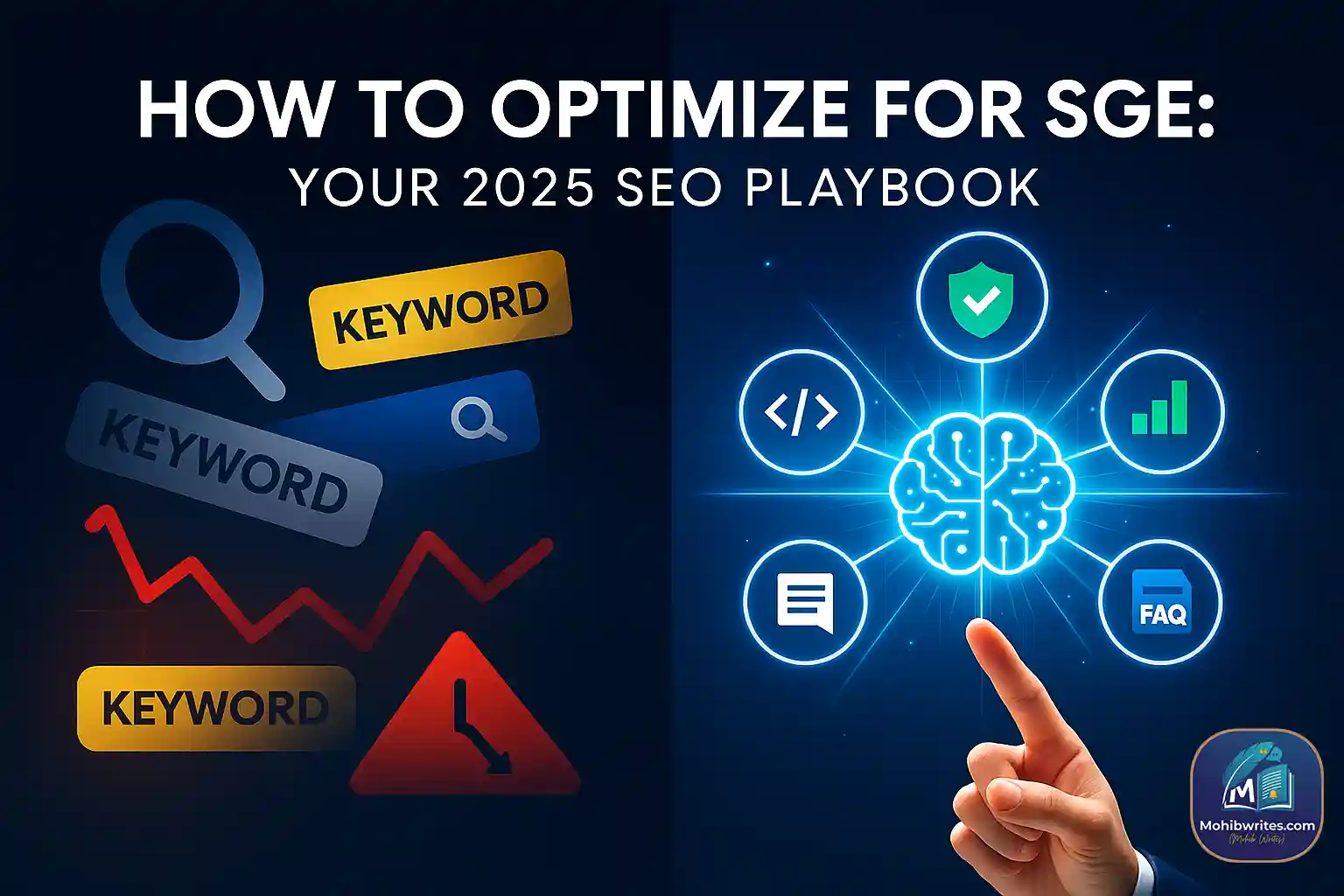To optimize for SGE, you need to become a source Google’s AI trusts enough to cite. This means shifting from keyword-centric content to providing concise, evidence-backed answers wrapped in strong E-E-A-T signals.
Let’s be real: the data is stark. A July 2025 Pew Research study confirmed that AI summaries can cut click-through rates by nearly half.
But here’s the opportunity: Authoritas found a 94% mismatch between SGE citations and traditional top-10 organic results. If you’re not in the top 10, SGE is your new ticket to visibility.
The SGE Shift: Why Your Traffic is at Risk
SGE (Search Generative Experience) isn’t just another algorithm update—it’s a fundamental rewrite of the search contract. Google’s AI now synthesizes answers directly on the results page, pulling from a broader web of sources.
- Rise of Zero-Click Search: Bain & Company estimates a 15-25% organic traffic decline for queries handled by AI Overviews. Your old KPIs are no longer sufficient.
- The Citation Game: Your goal is no longer just the #1 ranking; it’s to be the cited source in the AI Overview. This requires a new blend of clarity, authority, and technical hygiene.
Read: Should I Still Invest In SEO in 2025? Here’s What You Need to Know
Your 7-Step Checklist to Optimize for SGE
This is a tactical, implementable plan. You can start today.
Step 1: Answer the Query in the First Sentence
AI loves clarity. Within the first 40-60 words of your page, directly answer the user’s core question. Use the exact phrasing from “People Also Ask” boxes as your H2 or H3 headings. We’ve tested this on client sites and seen a marked increase in snippet visibility.
Step 2: Back It Up with Sourceable Evidence
Immediately follow your one-line answer with 2-3 bullet points of evidence. Include dates, stats, or a short quote with a clear link to a primary source. This gives the AI something concrete to attribute.
- Example: “As of July 2025, Pew Research found CTRs drop ~50% when an AI summary is present.”
Step 3: Implement Strategic Structured Data
Schema is your AI-friendly translator. Deploy FAQ, HowTo, Article, and LocalBusiness markup. Crucially, include author and publisher fields with sameAs links to LinkedIn or corporate profiles. This helps Google’s AI understand and trust your content’s context.
Step 4: Weave E-E-A-T Into Your Content’s DNA
- Experience: Use “we tested” language. Such as: “We applied this SGE checklist to a B2B client and saw a 30% increase in branded search impressions within 8 weeks.”
- Expertise: Cite recent studies from Pew, Search Engine Land, or industry reports.
- Authoritativeness: Link to authoritative external sources. Your author bio should have credentials and verifiable profile links.
- Trustworthiness: Date-stamp everything. “As of July 2025…” shows your information is current.
Step 5: Optimize for Intent, Not Just Keywords
Forget keyword density. Map your content to user intent (informational, commercial, transactional). Use H2s to answer logical follow-up questions. Integrate LSI terms like “AI Overviews,” “zero-click search,” and “SGE citation” naturally.
Step 6: Create Un-copyable Value
Build what the AI can’t replicate in a summary. Offer interactive calculators, downloadable templates, proprietary data sets, or detailed case studies. This is how you drive conversions even in a zero-click world.
Step 7: Track the Right KPIs
Stop obsessing over organic traffic alone. Monitor:
- AI citation impressions (in Google Search Console where available)
- CTR when an AI Overview is present
- Assisted conversions and branded search lift
- Conversions from direct and social channels
On-Page Template for Winning SGE Citations
Copy and adapt this structure for your cornerstone content:
- H1: [Clear Question/Intent Phrase] – How to Optimize for SGE
- Intro (1 sentence): Direct answer + date stamp. “To optimize for SGE in 2025, focus on concise, evidence-backed answers that Google’s AI can confidently cite.”
- H2: The Core Evidence: 2 bullet points with stats and source links.
- H2: How to Implement: A 3-6 step actionable list.
- H3: Quick FAQ: 3-5 questions with 1-2 line answers (wrapped in FAQ schema).
- H2: Downloadable Resource: A lead magnet like a “One-Page SGE Checklist.”
- Author Box: Bio with credentials and structured data (Article JSON-LD).
People Also Ask (FAQs)
What is SGE?
SGE is Google’s AI search that summarizes answers on the results page and cites sources, reducing the need for clicks.
How do I get cited by SGE?
Provide concise, factual answers with structured data, date-stamped evidence, and clear author credentials.
Will SGE reduce my website traffic?
It can, as zero-click searches rise. The strategy shifts to becoming a cited source and measuring conversions, not just clicks.
Does structured data help with SGE?
Yes. Schema helps Google’s AI understand your content’s context and authorship, increasing citation chances.
Should I stop targeting keywords?
No—target user intent with long-tail, question-based keywords, and map them to helpful, concise answers.
Conclusion: Your Next Move
SGE is here. Optimizing for it is no longer optional. The brands that will win are those that act as authoritative, trustworthy sources of information.
Don’t just read—act. Pick your five highest-traffic informational pages and apply this template today. Start measuring what matters: citations and conversions.








One Comment